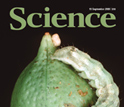News Release 08-158
Some Political Views May be Related to Physiology
New study reports physiological responses to disturbing images and sounds consistent with strong political beliefs

Researcher John Hibbing reports links between physiology and political beliefs.
September 18, 2008
View a video interview and podcast with researcher John Hibbing of the University of Nebraska-Lincoln.
This material is available primarily for archival purposes. Telephone numbers or other contact information may be out of date; please see current contact information at media contacts.
People who react more strongly to bumps in the night, spiders on a human body or the sight of a shell-shocked victim are more likely to support public policies that emphasize protecting society over preserving individual privacy. That's the conclusion of a recent study by researchers at the University of Nebraska-Lincoln (UNL). Their research results appear in the Sept. 19 issue of Science magazine.
The study, funded by the National Science Foundation (NSF), tested 46 people who identified themselves as having strong political opinions. Researchers showed subjects threatening visual images--pictures of a spider on a person's eyeball, a dazed person with a bloody face and an open wound with maggots in it--and monitored their skin for electrical conductivity, which indicates emotion, arousal and attention. In another physiological measure, the scientists surprised subjects with a sudden, jarring noise and measured how hard they blinked in response to being startled.
"Those with the strongest eye or skin reactions to unexpected noises or threatening pictures such as a spider on a person's eyeball tended to endorse political positions that were interpreted as protective of social groups," said John Hibbing, professor of political science at UNL.
Hibbing defined those "protective policies" as more defense spending, more government resources directed at fighting terrorism and tighter controls on immigration. "People in this group are more willing to sacrifice a little of their privacy to protect the social unit," Hibbing said. "On the other hand, the subjects who reacted less strongly to the stimuli were more likely to favor policies that protect privacy and encourage gun control."
The first group believes the greatest threat to them and their communities comes from other people; they want to arm themselves and their government to defend against those threats. The latter group sees less threat from people and more threat from technology and inanimate objects such as guns that can kill or harm innocent people. They want policies in place to protect their individual privacy and safety: They oppose the death penalty and favor strong gun control. The study controlled for subjects' gender, age and income.
NSF Program Officer Brian Humes said the Political Science Program at NSF sees this work as an important project that begins to link the sources of political preferences to biological mechanisms. "It also does so in a nuanced sense by stressing both the importance of environment and genetics," Humes said. "This linkage is one that could easily transform the manner in which political scientists and social scientists see the origins of preferences."
According to Hibbing, these research results may help explain why various political groupings often have trouble talking to each other about protective policies. "Maybe liberals and conservatives have difficulty understanding the views of the other side in part because they experience threats differently," he said. "Perhaps by recognizing these differences, tolerance of diverse political opinions could be facilitated."
In spite of these results, Hibbing stressed that a genetic predisposition to disturbing sounds and images is only one factor in determining an individual's political beliefs. Other factors such as environment and life experiences obviously play a part. "We're just talking about tendencies, it's far from determinative, but the fact that we can measure a difference at all is surprising and intriguing enough to warrant more study."
The study's co-authors at UNL are Kevin Smith, political science professor; Mario Scalora, psychology professor; and Doug Oxley, Matthew Hibbing and Jennifer Miller, graduate students. Additional co-authors are John Alford, Rice University political science professor, and Peter Hatemi, Virginia Commonwealth University postdoctoral fellow.
Hibbing and his team recently received additional funding from NSF to expand the scope of the study to include people with little or no opinion regarding protective policies. The new study will also include brain scans on subjects as they react to unexpected sounds and vivid imagery.
The study is part of a larger set of work funded by NSF's Political Science Program, the Decision, Risk and Management Science Program and the Human and Social Dynamics Initiative that links attitudes and behavior to both the environment and genetics.
-NSF-
-
View Video
John Hibbing shows the process for physiological testing of human responses to disturbing imagery.
Credit and Larger Version -
Play Audio
John Hibbing discusses research on physiological testing of human responses to disturbing imagery.
Credit and Larger Version -
The researchers' findings are published in the Sept. 19, 2008, issue of Science magazine.
Credit and Larger Version
Media Contacts
Diane E. Banegas, National Science Foundation, (703) 966-0316, email: dbanegas@nsf.gov
Kelly Bartling, University of Nebraska-Lincoln, (402) 472-2059, email: kbartling2@unl.edu
Program Contacts
Brian Humes, National Science Foundation, (703) 292-7284, email: bhumes@nsf.gov
Principal Investigators
John Hibbing, University of Nebraska-Lincoln, (402) 472-3220, email: jhibbing@unl.edu
The U.S. National Science Foundation propels the nation forward by advancing fundamental research in all fields of science and engineering. NSF supports research and people by providing facilities, instruments and funding to support their ingenuity and sustain the U.S. as a global leader in research and innovation. With a fiscal year 2023 budget of $9.5 billion, NSF funds reach all 50 states through grants to nearly 2,000 colleges, universities and institutions. Each year, NSF receives more than 40,000 competitive proposals and makes about 11,000 new awards. Those awards include support for cooperative research with industry, Arctic and Antarctic research and operations, and U.S. participation in international scientific efforts.
Connect with us online
NSF website: nsf.gov
NSF News: nsf.gov/news
For News Media: nsf.gov/news/newsroom
Statistics: nsf.gov/statistics/
Awards database: nsf.gov/awardsearch/
Follow us on social
Twitter: twitter.com/NSF
Facebook: facebook.com/US.NSF
Instagram: instagram.com/nsfgov



